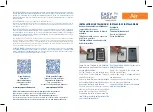
P
AGE
6
PN 950-001973-00, R
EV
. A
PN 950-001973-00, R
EV
. A
P
AGE
7
Tuning Your Rear Shock
By adjusting the air pressure, the RockShox Sid rear shock can be tuned to your particular weight, riding style
and terrain.This shock is designed to be tuned for the soft, plush downhill ride or the long climbs, or a
combination of both.
When tuning suspension, always make one change at a time and write it down. This takes patience, but allows
you to understand how each change affects your ride. Use a familiar trail to make small adjustments at a time.
To understand the tuning range it may also help if you ride one extreme to the other (low vs. high pressure or
maximum vs. minimum rebound). Keeping a record lets you know what changes you have tried that work
and suggests what changes you might try. Ask a shop or local riders what they have found works well. These
resources are typically your best bet, but don’t hesitate to call RockShox about specific tuning needs when
necessary. A list of phone numbers is on page 12.
Selecting Air Pressure (Spring Rates)
The air pressure you run in the shock varies depending on
weight and riding style. Air pressure can be changed in either
the positive or negative air chamber (see fig. 1). The following
sections will explain the differences between the positive and
negative air pressure as well as how to adjust both features.
C
OMPRESSION
A
IR
C
HAMBER
(P
OSITIVE
)
The valve on the large diameter of the shock is for positive air
pressure (fig. 1). Adjusting positive air pressure determines the
spring rate or stiffness of the shock. The more air you put in,
the firmer your shock will get.
For heavier, more aggressive riders, we recommend increasing the air pressure in the compression chamber.
By using a hand pump, you may change the air pressure in the positive air chamber (main spring).
G
OAL
:
Find the air pressure that allows you to use the maximum travel available. Ideally you want the shock to
occasionally bottom out.
D
O THE FOLLOWING TO ADJUST THE POSITIVE AIR CHAMBER FOR PROPER SPRING RATE
:
1.
Locate the positive (compression) air valve (fig. 1).
T
IP
: A
ROUND THE SHOCK IS A DECAL LISTING AIR PRESSURE RANGE
. T
HIS RANGE IS RECOMMENDED FOR
YOUR PARTICULAR BICYCLE AND SHOULD BE USED AS A STARTING POINT WHEN CHOOSING AIR PRESSURE
.
L
IGHTER RIDERS SHOULD START AT THE BOTTOM OF THE RANGE WHILE HEAVIER RIDERS SHOULD START AT THE
TOP
. W
E RECOMMEND STARTING OUT SOFTER AND WORKING YOUR WAY UP
.
2.
Remove the positive air valve cap. Slight air pressure may build up under the cap causing it to pop off,
this is normal. Be careful not to lose the cap.
Fig. 1
3.
Lightly thread constant fill adapter onto positive air valve. Do not over-tighten.
4.
Fill shock to desired spring rate (air pressure).
5.
Carefully push down on seat with pump installed. You may feel what the extra air does.
6.
Record the final PSI rating.
7.
Remove the pump once the spring rate is achieved.
8.
Reinstall the cap, tightening by hand.
N
EGATIVE
A
IR
C
HAMBER
The negative air valve (fig. 1) sets the characteristics (feel) of your bike. You may change the air pressure for
the negative spring using a hand pump.
Increasing the negative spring pressure is ideal for plush downhill riding. Decreasing the air is ideal for climbing.
D
O THE FOLLOWING TO ADJUST THE NEGATIVE AIR SPRING FOR DESIRED RIDE CHARACTERISTICS
:
1.
Locate the negative air valve.
T
IP
:
THE DECAL AROUND THE VALVE INCLUDES PRESSURE RANGES
. T
HIS WILL GIVE YOU YOUR STARTING POINT
FOR THE NEGATIVE AIR PRESSURE WHICH
E
QUALS POSITIVE PRESSURE
+/-20
PSI
. F
OR EXAMPLE
,
IF THERE IS
150
PSI IN THE POSITIVE AIR VALVE THEN
:
150 psi - 20 psi = 130 psi for a cross country ride
150 psi + 20 psi = 170 psi for a plush downhill ride
Between 130 to 170 psi gives you a mixture of cross country and downhill
2.
Remove the negative air valve cap. Slight air pressure may build up under the cap causing it to pop off,
this is normal. Be careful not to lose the cap.
3.
Lightly thread the constant fill adapter onto the negative air valve. Do not over-tighten.
4.
Fill the shock to the desired air pressure. We recommend starting with equal or slightly less pressure
than that of the positive air chamber. Notice the sag increases and the shock gets more supple as you
add more air into the shock. Add the desired negative air pressure.
5.
Remove the pump when the spring rate is achieved.
6.
Reinstall the cap.
A
DVANCED
T
UNING
H
INTS
•
Negative air pressure tunes sag. Typically, sag is 25 percent of all available wheel travel for cross
country and 33 percent for downhill.
•
Aggressive riding or rough terrain may warrant a higher spring rate.
•
Faster, more responsive steering can be achieved by decreasing the sag at the rear of the bike (increases
head angle). Slower and more stable steering can be achieved by increasing the sag at the rear of the
bike (decreases head angle).
Using less negative air pressure than positive air pressure will give you an easier climbing ride.
Using more negative air pressure than positive air pressure will give you a plush downhill ride.
•
To determine maximum travel, leave 50 psi in each air chamber (positive and negative). Place a zip-tie
around the body so that when the shock is compressed it moves the tie down on the body to mark
maximum travel. Push on the seat or ride the bike to determine maximum travel (be sure shock is
filled with air before riding).





































